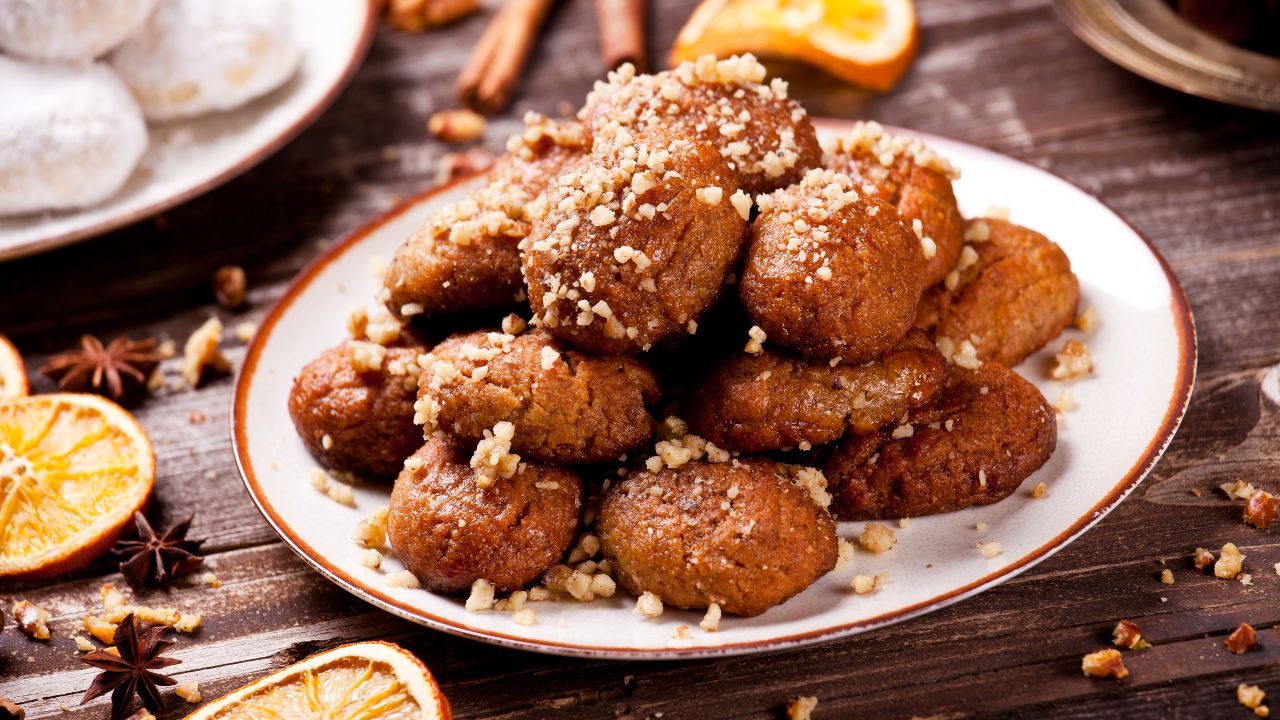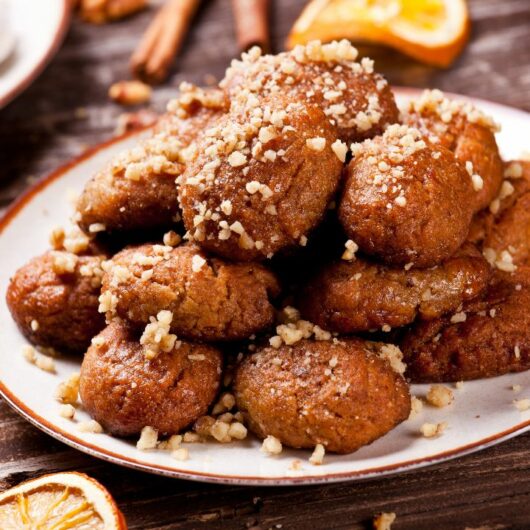Greek cuisine is known for its Mediterranean flavors and its fresh products, but it is also known for having some of the most delicious and unique-tasting desserts.

When it comes to cookies, in particular, it’s not only that Greeks love them, but they have also come up with some recipes that yield the most exquisite and distinct flavor cookies that are nowadays a traditional Greek treat.
Some of them come from Greek islands, others are classic Christmas cookies, and some others are the chewiest cookies you could ever make.
So, keep reading below to discover 14 delicious traditional Greek cookies, and check out the recipes to make your own!
1. Melomakarona
One of the two Greek Christmas cookies, melomakarona is made with semolina flour, orange juice, and lots of oil.
They are very delicate cookies and melt in your mouth right away. with aromas of cloves, cinnamon, and nutmeg, these cookies are baked and poured over with syrup.
You can also make them with a chocolate coating, so we suggest you make one batter and then use half of it to make the classic melomakarona and the rest to make some chocolatey ones.
2. Kourabiedes
It’s a never-ending debate about which Greek Christmas cookies are the best, as melomakarona have a foe: kourabiedes.
Kourabiedes are the traditional Greek almond cookie balls that people either love or love to hate. They are covered with icing sugar and taste like butter, almond, and rosewater.
So, if you are intrigued by unusual tastes, then this is a must-try!
3. Patouda (Honey And Date Cookies)
Nuts, dates, and honey are hidden inside these sugar-coated cookies that might remind people of British mince pies.
The pastry is made with olive oil, milk, sugar, flour, egg, and some raki – a strong spirit distilled from grape pomace – which makes these cookies Cretan and proud!
4. Amygdalota (Almond Cookies)
Calling amyglalota ‘almond cookies’ might make you think that they are just like any other almond cookie. Well, you are wrong!
Amygdalota, unlike other flour cookies with chopped almonds, is made with nothing but almond meal, egg whites, sugar, vanilla, and almond extract.
When out of the oven, they are crispy on the outside but extremely chewy on the inside, so don’t expect them to break once you dip them in your coffee!
5. Karidata (Greek Walnut Meringue Cookies)
If you are not a fan of almonds but you like the chewy aspect of them, then we have a Greek cookie alternative for you.
Karidata is chewy walnut cookies made with meringue, walnuts, cocoa powder, and orange blossom water.
They are sweet, soft, chewy, and easy to make, so save the recipe for later!
6. Moustokouloura (Greek Grape Molasses Cookies)
Another chewy cookie with Greek origins, moustokouloura is made with grape molasses, or what Greeks refer to as ‘petimezi.’
For the perfect chewiness, it’s important not to over-stir the batter that’s made with sugar, grape molasses, oil, honey, water, flour, baking soda, and spices.
Easy to make and ready in half an hour, they are more than worth a try!
7. Koulourakia (Greek Easter Cookies)
Greek Easter cookies are made with orange juice, mastic, brandy, and mahlab, which offer them their unique taste. That is why they are extremely popular among Greeks, and even though they call them Easter cookies, most bakeries are selling them all year long.
The recipe we have here yields some delicious Greek Easter cookies that are sugar-free! Made with the traditional Greek Easter cookie ingredients but replacing sugar with honey, they are not only a healthier version of the classic but one that is even more flavorful!
8. Ladokouloura (Greek Oil Cookies)
As you might have guessed by now, Greeks love their oil and their oranges!
Ladokouloura literally translates as ‘Oil Cookies,’ and this recipe yields some authentic Greek ladokouloura that you won’t believe just how easy it was for you to make them.
These cookies need 15-20 minutes to bake and another 10-15 minutes to prepare, so if you fancy treating your family to some, you can wake up an hour earlier than the rest of them and have them ready in time for breakfast!
9. Greek Tahini Cookies
Tahini is a Greek spread made from sesame seeds and it is a staple in most Greek people’s diets. It is mostly enjoyed as a spread on bread, crisp bakes, and butter cookies, but it is also added to cookie recipes like the one here.
These tahini cookies are vegan-friendly and made with a sweet, nutty tahini sauce that makes them perfectly sweet and chewy.
The important thing to remember when making these cookies is to go with a light oil option. Since you will use lots of it, its flavor might outdo the rest and be too strong for you to enjoy eating the cookies as you normally would.
10. Aegina Pistachio Cookies
The pistachios produced in Aegina are a trademark of the island and Greece, in general, and they are extremely popular all over Greece.
These cookies are made with these widely available Aegina pistachios and 6 more ingredients. Those are typical cookie ingredients like butter, sugar, flour, and salt, with the addition of cornstarch and a teaspoon of anise.
The combination of all these ingredients results in some nutty, sweet cookies that go perfectly with a cup of hot chocolate.
Easy to make and ready in less than 30 minutes, they are very palatable and a safe choice for a Greek cookie that everyone will like.
11. Aximadia (Greek Orange And Almond Olive Oil Cookies)
Paximadia is what Greeks call their double-baked cookies that come both in sweet and savory flavors.
The paximadia made with this recipe is rather sweet, but the ratio of olive oil and almonds to sugar makes their taste rather balanced.
To make these double-baked cookies you will need olive oil, orange juice, sugar, baking soda, flour, baking powder, almonds, and some other optional ingredients like cinnamon, anise, and mastic.
Before baking your paximadia for the second time, you can bake them for less time to get them out slightly softer than you would if you baked them for longer.
However, since paximadia are coffee-dipping cookies, don’t worry about them being too hard to chew as you will dip them in your cup before every bite!
12. Phoinikota (Date And Walnut Filled Cookies)
Phoinikota traditionally originated in Cyprus, but Greece’s inextricable link with the country meant that these cookies would become just as much Greek as they are Cypriot.
Filled with walnuts, pistachios, and dates mixed with spices and rose water, these cookies are sprinkled with icing sugar and served warm or at room temperature.
They are a great option for people who want to bake lots of cookies to treat guests on a busy week full of home visits as they can be kept out on a big tray for people to be served on their own.
Their texture and look remind a bit of that of kourabiedes, but their filling is so different that even if you choose to make both of these cookies, you will still have some great variety.
13. Mamoulia (Greek Nut-Filled Cookies)
Mamoulia is a celebration Greek cookie that is typically made on the Greek island of Chios, yet they are also popular on some other Greek islands.
The cookies are made by shaping a dough made with flour, butter, fresh milk, sugar, eggs, olive oil, baking soda, baking powder, and brandy into tiny balls and stuffing them with a nuts mix.
Mamoulia is frequently shaped like pears, and they are sprinkled with flower water and covered with sugar.
14. Roxakia
Roxakia is some Greek cookie swirls covered in syrup with a distinctive look. A small, brown-colored circle in the middle is ‘hugged’ by a bigger golden one.
Essentially, roxakia visually look like fluffy dumplings with a chocolate heart. The basic ingredients of roux are flour, butter or oil, and sugar syrup. Other ingredients can be milk and various spices (eg cinnamon).
It is a very tasty treat that is also extremely sweet thanks to the addition of the syrup, so if you’d prefer having it in bite-sized portions you can make the small roxakia.
Alternatively, do for the classic big rox and you won’t be disappointed!
Are Dutch and Greek cookies similar in texture and taste? Although both countries offer a rich variety of traditional treats, the classic cookies from the netherlands differ from those found in Greece. While Dutch cookies have a distinctive buttery and crisp texture, Greek cookies often lean towards a softer and chewier consistency. Likewise, their tastes vary, with Dutch cookies boasting a delightful sweetness and Greek cookies showcasing unique flavors like honey or nuts.
The Bottom Line
These 14 traditional Greek cookies are made with ingredients that remind everyone of Greece, as most of them are made with olive oil, nuts, and juice from fresh oranges which, if you’ve been to Greece, you know you can find in abundance.
So, save some of these recipes for the next time you want to spend time baking something different for your friends and family!
Frequently Asked Questions
One of the most popular and delectable Greek desserts is loukoumades. It’s available everywhere, from Greek food places to vendors on the streets.
These delicious honey balls are prepared with a yeast dough that is skillfully separated into small balls after rolling, and then deep fried in seconds. Loukoumades are served with honey or chocolate syrup on top and best enjoyed when hot.
- 15 Traditional Greek Breads - July 31, 2023
- 30 Delicious And Gluten-Free Cookie Recipes - July 29, 2023
- 30 Of The Best European Desserts - July 29, 2023

